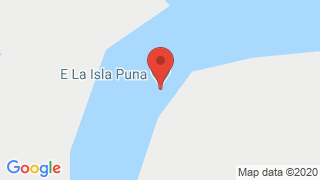Isla Puná – Avitourism (Bird watching)



Ecuador Puná Island
Puná
Thanks to its geological formations, it is possible to appreciate a succession of ecosystems, from the mangrove forest located in ample terraces that oscillate between 0 and 80 m.a.s.l. to mountainous formations such as the Zambapala mountain range located at 300 m.a.s.l. where the very dry tropical forest ecosystem predominates. Around 54 migratory species can be observed in its wetlands between October and April.
Approximate Travel Time 2 hours
How to get to Isla Puná?
Leaving the city of Guayaquil by the highway E40 via the Coast you reach Progreso parish where you will take the detour to Playas to enter the highway E489 in the direction to Posorja parish. From the fishing port of Posorja, you will start a 20-minute boat ride to Bellavista commune on Puná Island.
Representative Birds of Puná Island
- Scientific name: Synallaxis stictothorax
- Family: Furnariidae
- English name: Necklaced Spinetail
- Spanish Name: Colaespina Collareja
- Scientific name: Polioptila plumbea
- Family: Polioptilidae
- English Name: Tropical Gnatcatcher
- Spanish Name: Perlita Tropica
- Scientific name: Haematopus palliatus
- Family: Haematopodidae
- English name: American Oystercatcher
- Spanish Name: Ostrero Americano
Birds of Interest
- Scientific name: Pelecanus thagus
- Family: Pelecanidae
- English Name: Peruvian Pelican
- Spanish Name: Pelícano Peruano
- Scientific name: Aramides axillaris
- Family: Rallidae
- English name: Rufous-necked Wood Rail
- Spanish name: Rascón Cuellirrufo
- Scientific name: Athene cunicularia
- Family: Strigidae
- English name: Burrowing Ow
- Spanish Name: Búho Terrestre
Services of Puná Island
- Hosting
- The best place to stay is the inn of the Cauchiche commune, at the foot of the beach of the same name, which has several rooms with private bathroom as well as recreational facilities available to tourists.
- Food and beverages
The supply of food is not constant, being weekends and holidays when surely the service is present, otherwise it is necessary to request it to the inhabitants of the sector who will kindly provide it for a modest price.
- Avitourism
- The island does not have specialized birdwatching guides.
- On the island you can make various tours through existing habitats, for the sighting of coastal seabirds, there are boat tours by Farallones islets and the wide beach and mangrove of the communes Bellavista, Estero de Boca, Cauchiche and Subida Alta, on the other hand for birdwatching Tumbesinas, the island has the Interpretation Center and the ecological trail of the commune Campo Alegre, which crosses a forest of giant ceibos.
- Recommendations
- It is recommended to make the reservation in advance of the services required in your visit and call the president of the commune Campo Alegre to enter the trail.
- Keep in mind that on holidays the influx of tourists increases.
- For the route by the footpaths, to use comfortable clothes that cover the extremities, shoes for stony walks, rubber boots for walks by the manglar, cap, solar protector, repellent for insects, binoculars of high amplitude, receptacle with water and a refreshment.
- Other Attractions
- The main attraction of the island is the sun and beach tourism, where the visitor can relax and enjoy a wide variety of activities. You can also visit the tourist attractions of the communes, such as the Mirador de Subida Alta and the Bridge of the commune Bellavista, or make boat rides in search of the Bottle Nose Dolphin.
- Finally, it is fascinating at night to admire the shooting stars in a clear sky while plankton performs a show of bioluminescence among the waves of the beach.
- Contacts
- Francisco Parrales
Association of Tourist Boats Pelícano
Telephone: 593 99 7103462
- Wilmer Torres
President Comuna Campo Alegre
Telephone: 593 99 9654310

Publicado en:
Publicado por:



